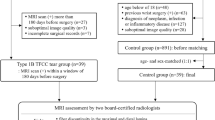Abstract
The aim of this study was to assess the value of direct magnetic resonance (MR) arthrography of the wrist for detecting full-thickness tears of the triangular fibrocartilage complex (TFCC). Twenty-four consecutive patients who had ulnar-sided wrist pain and clinical suspicion of TFCC tear were included in the study. All patients underwent direct MR arthrography and then wrist arthroscopy, and the results of MR arthrography were compared with the arthroscopic findings. The positive predictive value of MR arthrography in detecting TFCC full-thickness tear was 0.95, and the negative predictive value was 0.50. The sensitivity of MR arthrography in detecting a TFCC full-thickness tear was 74% (15/19), and specificity was 80% (4/5). The overall accuracy of MR arthrography in detecting a full-thickness tear of the TFCC in our study was 79% (19/24). We believe that diagnosis of tears in the TFCC by direct MR arthrography is not entirely satisfactory, although MR arthrography has a high positive predictive value for detecting TFCC tears. Negative results of MR arthrography in patients with clinical suspicion of TFCC tear should be interpreted with caution.
Résumé
Le but de cette étude est d’évaluer la valeur de l’arthro IRM du poignet don’t le diagnostic est rupture complète du ligament triangulaire (TFCC). Une série continue de 24 patients qui avaient des douleurs du bord ulmaire du poignet et une suspicion clinique de lésions du TFCC ont été inclus dans la série. Tous les patients ont eu une arthro IRM et ensuite une arthroscopie du poignet. Les résultats de l’arthro IRM ont été comparés avec les constatations arthroscopiques. La valeur prédictive positive de l’arthro IRM dans la détection des ruptures complètes du TFCC était de 0,95 et la valeur prédictive négative était de 0,50. La sensibilité de l’arthro IRM dans la détection des ruptures complètes du TFCC étaient de 74% (15/19) et la spécificité était de 80% (4/5). La capacité globale de l’arthro IRM dans la détection des ruptures complètes du TFCC dans notre étude était de 79% (19/24). Nous pensons que le diagnostic des ruptures du TFCC par arthro IRM n’est pas complètement satisfaisant bien que cet examen ait une valeur prédictive positive élevée dans la détection de ces lésions. Une arthro IRM négative, chez un patient qui présente une suspicion clinique de rupture du TFCC doit être interprétée avec précaution.
Similar content being viewed by others
References
Cerofolini E, Luchetti R, Pederzenni L et al (1990) MR evaluation of triangular fibrocartilage complex tears in the wrist: comparison with arthrography and arthroscopy. J Comput Assist Tomog 14:963–967
Golimbu CN, Firooznia H, Melone CP Jr et al (1989) Tears of the triangular fibro cartilage of the wrist: MR imaging. Radiology 173:731–733
Haims AH, Schweitzer ME, Morrison WB et al (2003) Internal derangement of the wrist: indirect MR arthrography versus unenhanced imaging. Radiology 227:701–707
Herold T, Lenhart M, Held P et al (2001) Indirect arthrography of the wrist in the diagnosis of TFCC lesions. Rofo 173(11):1006–1011
Kato H, Nakumara R, Shinoya K et al (2001) Does high-resolution MR imaging have better accuracy than standard MR imaging for evaluation of the triangular fibro cartilage complex. J Hand Surg [Br] 26(5):502–503
Levisohn EM, Rosen ID, Palmer AK (1991) Wrist arthrography: value of the three compartment injection method. Radiology 179:231–239
Meier R, Schmitt R, Krimmer H (2005) Wrist lesions in MRI arthrography compared with wrist arthroscopy. Handchir Mikeochir Plast Chir 37(2):85–89
Metz VM, Mann FA, Gilula LA (1993) Three compartment wrist arthrography: correlation of the pain site with location of uni- and bidirectional communications. Am J Roentgenol 160:819–822
Morley J, Bidwell J, Bransby-Zachary M (2001) A comparison of the findings of wrist arthroscopy and magnetic resonance imaging in the investigation of wrist pain. J Hand Surg [Br] 26(6):544–546
Pederzini L, Luchetti R, Soragni O et al (1992) Evaluation of the triangular fibro cartilage complex tears by arthroscopy, arthrography and magnetic resonance imaging. Arthroscopy 8:191–197
Potter HG, Asnis-Ernberg L, Weiland AJ et al (1997) The utility of high resolution magnetic resonance imaging in the evaluation of triangular fibrocartilage complex of the wrist. J Bone Joint Surg A 79-A:1675–1684
Schweitzer ME, Brahme SK, Holder et al (1992) Chronic wrist pain: spin-echo and short tau inversion recovery MR imaging and conventional MR arthrography. Radiology 182:205–211
Zlatkin MB, Chao PC, Osterman AL et al (1989) Chronic wrist pain: MR imaging. Radiology 173:723–729
Further reading
Grissom LE, Harcke HT (1997) Ultrasonography of nondevelopmental dysplasia of the hips. Pediatr Radiol 27:70–74
Author information
Authors and Affiliations
Corresponding author
Additional information
An erratum to this article can be found at http://dx.doi.org/10.1007/s00264-007-0474-y
Rights and permissions
About this article
Cite this article
Joshy, S., Lee, K. & Deshmukh, S.C. Accuracy of direct magnetic resonance arthrography in the diagnosis of triangular fibrocartilage complex tears of the wrist. International Orthopaedics (SICO 32, 251–253 (2008). https://doi.org/10.1007/s00264-006-0311-8
Received:
Revised:
Accepted:
Published:
Issue Date:
DOI: https://doi.org/10.1007/s00264-006-0311-8




